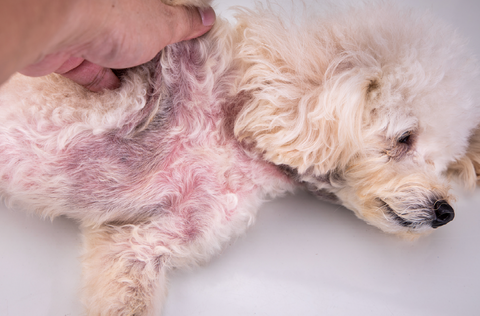How to relieve common skin disorders in dogs
June 30, 2022

Published: May 2021 | Updated: June 2022
One of the most common reasons dog lovers visit their veterinarian is for skin issues. Excessive scratching, redness, itching, hair loss, and lumps and bumps may indicate a variety of dog skin problems, ranging from allergies, fleas, and ticks to infections and mange, or even poor gut health!
Allergies and Skin Reactions
Allergic reactions in dogs may occur as a result of factors in their environment or in their food. Canine atopic dermatitis is an allergic reaction to pollen, dust, plants, and grass in the air. Frequent scratching due to the persistent sense of itchiness is the most common symptom that your dog has an airborne allergy.
Scratching can lead to other issues such as wounds, scabbing and your dog’s inflamed skin. Inflammation within their nose and ear infections are two less common symptoms.
Allergies in dogs can manifest themselves during specific seasons or throughout the year. Although food allergies are less common than airborne allergies, they exhibit similar symptoms.

Fleas
Fleas are a nuisance to both our dogs and us. They can not only cause your pet pain and annoyance, but they can also spread diseases. They can even infest the carpets, beds, and other living spaces.
Adults lay eggs on our dogs, which are then dispersed around our home while our dog runs about. The larvae that hatch from these eggs eventually infest our dogs, our home, and can even be found in our vehicles!
The most common symptom of flea infestation is constant scratching and a dog with itchy skin, but this may lead to secondary skin problems such as wounds and bleeding.
Ticks
While most dog lovers are familiar with fleas, many are unaware of the other major parasite that poses a danger to our pets during the spring and summer months (and even the fall): TICKS! Ticks, like fleas, feed on the blood of their hosts, and they prefer a wide range of hosts (dogs, cats, rodents, rabbits, cattle, small mammals). Although fleas avoid human blood, ticks have no qualms about clinging to and feeding on humans. If you find a tick on your dog, be sure to check yourself and your family as well.
It is important to remove a tick from your dog as soon as possible. When extracting a tick, you must be extremely cautious because if the head is left in your dog, it can abscess and cause infection, and any contact with the tick's blood will possibly transmit disease to your dog or to you. Bringing your dog to the vet and having one of the technicians remove it is the safest way to ensure a safe, successful removal.

Bacterial Infections
Bacterial skin infections in dogs may occur as a result of other factors; for example, an itchy dog with skin allergies can cause wounds that become infected. Bacterial infections come in a variety of forms, but the most common is known as bacterial folliculitis, which is an infection and inflammation of the hair follicles. Folliculitis is characterized by a dog’s red itchy skin, swellings and pustules.

Mange
Mange is a skin condition brought about by mites. There are two forms of mange in dogs:
- Sarcoptic mange (also known as canine scabies) is the most common form of mange.
- Demodectic mange is passed down from mother to puppy.
Mange makes dogs very itchy, causing them to scratch excessively, resulting in cuts, scabs, and hair loss.
Sarcoptic mange is extremely contagious among dogs and can also be transmitted to humans, but the mites can only live for a short time on our skin.
Mange is treatable, but if you're worried that your dog has it, you should call your veterinarian and make an appointment as soon as possible. If you have more than one dog, inform your veterinarian because they will need to be treated as well (even if they show no symptoms).

Yeast Infections
One of the most common skin disorders in dogs is yeast infections. Yeast is a fungus that grows on your dog's skin and is usually harmless. But, changes in your dog's skin (such as allergies or excessive oil production) may cause the yeast to multiply excessively.
The body then attempts to reduce the yeast population, resulting in crusting, scratching, and odor on the skin, which can gradually thicken. Yeast in dogs is not infectious, but it's extremely uncomfortable for your dog.

Your Dog’s Gut Health is Related to Their Skin and Coat
You would be surprised at how much your dog’s gut health affects her entire body, including her skin and coat. At least 70% of your dog's immune system is thought to be housed in his gut microbiome. Basically this means that 70% of your dog’s overall health rests on the balance of his digestive system.
Have you ever heard the phrase, “you are what you eat?” Well, that’s where that phrase comes from. You truly are what you eat. If your dog isn’t eating a well-balanced diet, that will show through in all aspects of health, including the skin (and the same goes for us).
An overabundance of bad bacteria in the canine GI tract can cause dog skin conditions. Yeast infections and itching, particularly in your dog's ears, are common symptoms of poor gut health.
Additional signs of poor gut health include excessive shedding, excessive licking (to the point of hot spots), and continuous, overwhelming itchiness leading to inflamed, red or dry scaly dog skin.
Canine Probiotics Help Improve Gut Health
To improve gut health, and in turn improve skin and coat health, implementing a canine probiotic powder could prove extremely beneficial.
As funny as it sounds, high-quality probiotics for dogs can double as dog supplements for itchy skin and help to prevent and treat allergies and atopic skin conditions like the ones outlined above!
A veterinarian-formulated probiotic, like Daily Dog, can also reduce or eliminate food allergies which are a common culprit for skin conditions in our dogs.
Probiotics improve digestion and balance the bad bacteria in the gut helping our dogs fight any pathogens, and therefore increasing the colonies of good bacteria found within the digestive tract.

